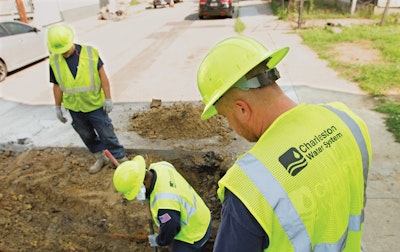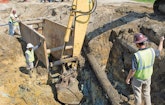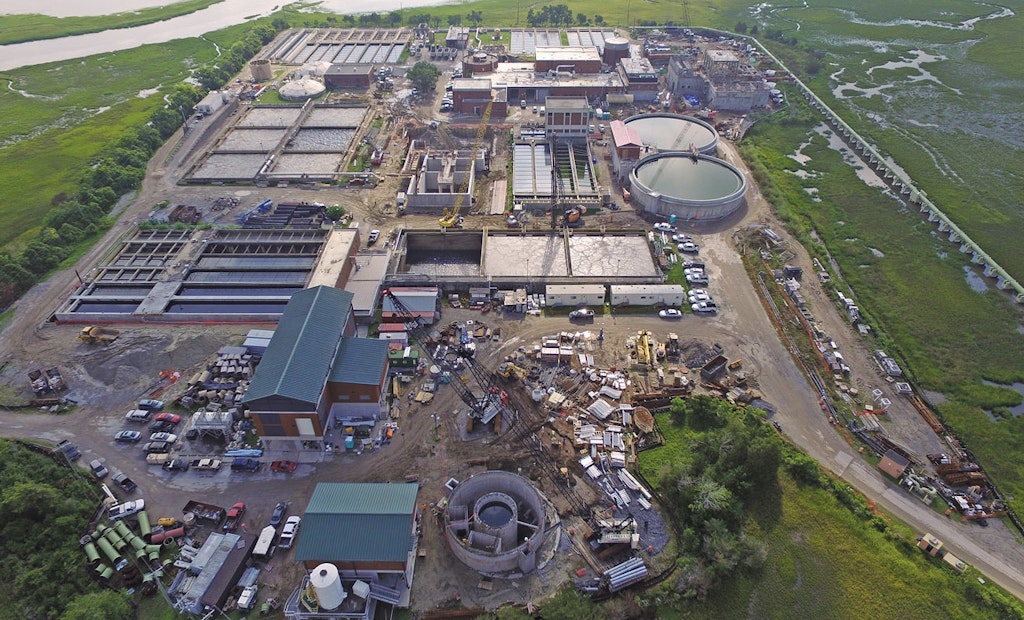To the Charleston (South Carolina) Water System, the future is just as important as the past. Home of significant “firsts” in the municipal drinking water field — including the first cement-lined cast iron water pipe in 1922 — Charleston is in the midst of a comprehensive capital improvements program to help it rehabilitate infrastructure and meet the needs of its rapidly growing service area.
“Some of the original 100-year-old pipe is still in service,” says Kin Hill, CEO. “With current-day rehabilitation technologies, we are confident that we can get at least another 50 years of service life from these assets.”
And while rightly proud of its history, which goes back to 1917 and even earlier, Charleston Water System has completed one round of extensive capital improvements and is planning for a second, as the local population surges and the agency deals with a topography that includes large tidal river crossings, coastal estuaries and wetlands.
Water and wastewater
Charleston Water System is an independent public utility responsible for supplying drinking water and treating wastewater for the city of Charleston and portions of neighboring Berkeley and Dorchester counties.
The water service area covers 450 square miles and includes 1,800 miles of water mains, ranging in size from 1 and 2 inches up to 84 inches in diameter, as well as 9,000 fire hydrants.
The Bushy Park Reservoir, owned by the utility and located in Berkeley County, and the Edisto River are the raw water sources. Treatment takes place at the Hanahan Water Treatment Plant, a 115.6 mgd-rated conventional surface water treatment facility. The plant, originally owned by Charleston Light and Water Co., has been in operation since 1904.
“The two sources represent quite different water quality,” Hill explains. “We have seasonal variations in the Bushy Park Reservoir water, and the water from the Edisto River is high in organics and color and has low turbidity and alkalinity. We blend the two streams at the Hanahan plant, usually about 90 percent from the reservoir and 10 percent from the river.”
The plant normally produces 60 to 70 million gallons of finished water per day.
Unique to Charleston are hand-excavated tunnels that bring the source water to the plant. “We own the rights to the water in the reservoir,” explains Mark Cline, capital projects officer.
The plant includes multiple clearwells totaling 12 million gallons and has a 1.5 million gallon elevated storage tank. The distribution system features over 20 million gallons of storage capacity in five ground storage tanks. System pressure is maintained at approximately 100 psi, except in the older Peninsula area of the city where a lower pressure zone is maintained.
Altogether, the water system serves about 120,000 retail accounts and wholesales water to nine different area municipalities including Joint Base Charleston for the U.S. Department of Defense.
The utility treats wastewater from an area of 250 square miles and about 56,000 accounts at the Plum Island Wastewater Treatment Plant, which is its main plant. Wastewater moves through a system of 900 miles of sewers, boosted by more than 200 pumping stations. It enters the treatment plant through either the West Ashley Tunnel or the Harbor Tunnel — deep underground interceptors 100 to 125 feet below the surface.
Another small treatment facility exists on Daniel Island, providing preliminary treatment with screening and odor control before the wastewater flows by deep tunnel to Plum Island.
Planning for the future
The Charleston area has experienced rapid growth in recent years and people continue to move into the area.
Hill says the influx averages 38 people a day. “It’s been unprecedented growth,” he says, with the major share of it coming in the outlying areas of Dorchester and Berkeley counties, with current populations of 156,000 and 217,000, respectively. About 410,000 people live in Charleston County.
“We added 2,000 water taps and 500 sewer taps last year,” Hill says. “Our water service area is two to three times what it used to be, and we’re now providing wholesale water to nine different accounts.”
Cline points out that the rising population has resulted in high-density building in the downtown area, and many high-rise buildings, which have put additional strain on the utility’s older water and wastewater infrastructure.
This growth, the changing building patterns, and the age of the water and wastewater systems have made capital improvements essential if Charleston Water System is to continue to provide the high level of service to its customers.
To accommodate the growth, the utility has developed a comprehensive capital improvement plan. “We master-planned our entire system, including distribution, collections, and treatment plants,” Cline says.
“We operate on a 25-year cycle, with 4- to 5-year phases of planned improvements. We work with our staff and our consultants and look at needs based on historical growth projections, as well as replacement or rehabilitation of existing assets.
“Then we vet and prioritize each project — core projects, as well as priority repair projects.”
The capital improvement plan and its projected bond funding is first presented to the Charleston Water System’s Board of Commissioners and then taken to the Charleston City Council for approval of bond indebtedness.
“We use revenue bonds, rate revenue including retained earnings, and impact fees to fund the projects,” Cline says.
Hill notes that the utility has a triple-A bond rating and typically adjusts its rate structure upward in small annual increments, based on regular rate studies prepared by the consulting firm Black & Veatch. “The average increase is 2 to 4 percent, although we had no rate increases in 2017,” Hill says.
Key capital projects
Take a look at the Charleston Water System website and you’ll find an interactive map with over 80 capital projects identified and described.
According to its planning documents, the utility must continue to make improvements to its water and wastewater treatment plants, and to the distribution and collections systems, to ensure available capacity to meet water demands associated with growth and fire protection, as well as projected growth-related wastewater flows.
The current capital improvement plan investments total $98 million for drinking water improvements and $162 million for wastewater.
While many of the capital projects are associated with roadway improvements and pipeline and facility replacements, a number of them are extensive and involve significant funding and advance planning.
Russell Huggins, director of engineering and construction, and Don Benjamin, assistant director, have major responsibility for these large projects.
At the Hanahan plant, Charleston Water System has tackled nearly $62 million worth of projects aimed at improving efficiency and boosting capacity. Upgrades included replacing older, space-consuming sedimentation basins with new high-rate plate settlers with integrated flocculation cells. A new air-water scour system was also installed at the Stoney Filter Plant. “We gained extra filtration depth and we’ll be able to change to biological filtration in the future if necessary,” Benjamin says.
The Ashley River Transmission Line Crossing is another major project, replacing a deteriorated 24-inch waterline that had been abandoned. Nearly 4,700 feet of new 36-inch pipe was installed under the river, using horizontal directional drilling (Mears).
“It’s the first of several phases of transmission main improvements recommended in the master plan to address water demand and fire flow needs in the West Ashley area,” Huggins says. The total anticipated project cost is approximately $18.5 million.
In addition to running new lines to serve growth areas, Charleston Water System also cleans and rehabilitates older, existing piping. In downtown Charleston, some of the cast iron pipes date to the late 1800s. “Many of these lines are structurally OK,” Hill says. “We mechanically scrape the inside walls clean and then line them with cementitious grout, using rotary spray head and trowel technology.
“We can regain capacity — restore their life and flow characteristics — without having to dig them up and replace them.”
He says the cost of cleaning and lining is about one-third that of full replacement.
Wastewater improvements
Major upgrades are taking place in the wastewater system as well. At the Plum Island plant, a $70 million project is improving process controls and the SCADA system, rebuilding the old headworks, primary and secondary clarification basins, and adding an anoxic selector zone to cope with increased ammonia flows into the plant. “The new basins will give us needed redundancy and additional control of our treatment process,” Benjamin says.
The largest effort involves replacement of the network of deep tunnels carrying wastewater to the Plum Island plant. Costing over $200 million, the project is now in its fifth of six phases — replacement of the old West Ashley Tunnel, which carried about 19 mgd. Like the other tunnels in the network, West Ashley was experiencing deterioration of the carrier pipe as well as capacity issues.
The fifth project phase, wrapping up in early 2019, involves digging a 1.6-mile-long 120-foot-deep tunnel, 8 feet in diameter. The new tunnel will have a capacity of 60 mgd.
The new tunnel terminates at a new 75 mgd influent pumping station at the plant. The new pump station shaft, 60 feet in diameter, was installed using the caisson method of construction to maintain a dry environment for workers. Huggins says 430 hp Flygt dry pit submersible pumps rated at 15 mgd are being used to lift tunnel contents to the plant headworks.
Hill adds that future improvements will include reworking the solids handling portion of the Plum Island plant.
“Our master plan includes long-term alternatives for biosolids treatment and disposal,” he says. “It will involve consideration for possible regional collaboration and digestion. We’re going to give that a long, hard look in the next five years and include our water plant residuals in the alternatives study plan.”
Award winners
Through it all, the Charleston Water System has kept its eye on excellence. In June, the Hanahan plant achieved the 15-year Directors Award level in the Partnership for Safe Water program, and the utility received a Platinum Peak Performance Award from the National Association of Clean Water Agencies in 2012.
Every year since 2011, Charleston Water System has ranked as One of the Best Places to Work in South Carolina.
Perhaps most noteworthy, however, is that Charleston Water System was the first water and wastewater utility in the nation to achieve the ISO 14001 certification for environmental management (EMS).
“The entire company has been involved in that EMS certification,” Hill says. “From capital projects to operations, financial, management, and planning. It’s how we prioritize; it’s the basis for what we do. We’re really proud of that.”
A century of service
The Charleston (South Carolina) Water System recently reached the 100-year mark, having been founded in 1917 when Charleston’s City Council created the Water Commission to manage the city’s water supply.
Actually, Charleston Water System’s roots go even deeper since the old Hanahan Steam Pumping Station, built in 1903, is now the site of the agency’s Hanahan Water Treatment Plant. And the city’s first water supply — an artesian well dating to 1879 — was recently declared a historic landmark.
As they say, a lot of water has passed under the bridge since then.
In 1917, the city of Charleston purchased the Goose Creek Reservoir and pumping station from the Charleston Light and Water Co. for $1.3 million and the system became operational.
In 1917-18, a drought and damage to the Goose Creek Dam forced the agency to seek an additional source of water, temporarily from the Ashley River via a wood-stave pipeline to the reservoir.
In 1937, Charleston Water System started drawing on a more permanent source of water from the Edisto River via a 22-mile-long tunnel. The tunnel took nine years to build and supplied 70 mgd to the Hanahan plant, a supply that continues today.
In the 1950s, recognizing the need for even more water for industrial development, Charleston built the Bushy Park Reservoir and began feeding water via a tunnel to the Hanahan plant. Bushy Park is the agency’s primary water source today.
Meanwhile, the Hanahan plant has been expanded through the addition of the Booker and Stoney filter plants and numerous other upgrades. In 1968, Charleston Water System installed its 50,000th meter.
On the wastewater side, Charleston mirrors the progress of treatment in cities across the country, as regulations associated with Clean Water Act began to take effect in the 1970s.
Prior to that, wastewater had been discharged directly to Charleston Harbor. But by 1970, Charleston had built the Plum Island Wastewater Treatment Plant, which provided primary treatment of up to 18 mgd. Secondary treatment was added in 1981, and during the 1990s, capacity was expanded to 27 mgd and finally to 36 mgd — its capacity today.
In addition, a smaller treatment plant on Daniel Island, constructed after the island was annexed to the city, provides preliminary treatment for a relatively small volume of wastewater, which is then piped under the Cooper River to Plum Island.








